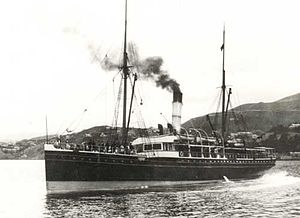| SS Penguin | |
|---|---|
 SS Penguin | |
| Career (New Zealand) | |
| Name: | SS Penguin |
| Owner: |
|
| Builder: | Tod and Macgregor, Glasgow |
| Yard number: | 128 |
| Launched: | 21 January 1864 |
| Identification: | Official number: 47849 |
| Fate: | Wrecked, 12 February 1909 |
| General characteristics [1] | |
| Type: | Passenger/cargo steamship |
| Tonnage: |
|
| Length: | 220 ft 6 in (67.21 m) |
| Beam: | 28 ft 6 in (8.69 m) |
| Depth: | 14 ft 4 in (4.37 m) |
| Propulsion: |
|
| Speed: |
|
SS Penguin was a New Zealand inter-island ferry steamer that sank off Cape Terawhiti near the entrance to Wellington Harbour in poor weather on 12 February 1909. Of the 105 passengers and crew on board, only 30 survived the sinking. This was New Zealand's worst maritime disaster of the 20th century.
Ship history[]
Penguin was built by Tod & McGregor of Glasgow, Scotland, for G. & J. Burns of Glasgow, and launched on 21 January 1864. Registered in Glasgow on 4 April 1864, she was finally sold to the Union Steamship Company in 1879, and was extensively refitted in 1882.[1]
Sinking[]
Penguin departed Picton on 12 February 1909 bound for Wellington in good conditions. However by 8 p.m. the weather had deteriorated, with strong winds and poor visibility. At 10 p.m Captain Francis Naylor headed further out to sea until the weather cleared. However as the ship turned, it struck Thoms Rock, and water poured in. Although women and children were loaded into the lifeboats first, these foundered in the rough seas. Only one woman survived, and no children. Other survivors drifted for hours on rafts before reaching safety. As the Penguin sank, seawater flooded the engine room. As the cold water reached the red-hot boilers a huge explosion tore the ship apart.[2]
Following the disaster, a half-day holiday was declared in Wellington to allow the many funerals to be held.[3] About forty of the victims were buried in Karori Cemetery, where a self-guided walk now wanders past their grave sites.
A court of inquiry found the ship struck Thoms Rock, near the mouth to Karori Stream in Cook Strait. The captain maintained that it had struck the submerged hull of the Rio Loge, lost the month before.[4] On the 100th anniversary of the sinking, Wellington's mayor unveiled a plaque remembering the disaster at Tongue Point, near the site of the wreck.[5]
References[]
- ↑ 1.0 1.1 "SS PENGUIN". Clyde-built Ship Database. 2013. http://www.clydesite.co.uk/clydebuilt/viewship.asp?id=14352. Retrieved 31 January 2013.
- ↑ "SS Penguin - New Zealand Disasters". Christchurch City Libraries. 2013. http://christchurchcitylibraries.com/Kids/NZDisasters/SSPenguin.asp. Retrieved 31 January 2013.
- ↑ "SS Penguin wrecked in Cook Strait". nzhistory.net.nz. 2013. http://www.nzhistory.net.nz/ss-em-penguin-em-wrecked-in-cook-strait. Retrieved 31 January 2013.
- ↑ Wood, Stacey; McDonald, Greer (11 February 2009). "Search for wreck of Penguin". http://www.stuff.co.nz/dominion-post/archive/national-news/1397733/Search-for-wreck-of-Penguin. Retrieved 11 May 2012.
- ↑ SS Penguin Sinking to be Remembered on South Coast, Wellington City Council, 9 February 2009.
Further reading[]
- Collins, Bruce (2000). The Wreck of the Penguin. Wellington: Steele Roberts Limited. ISBN 1-877228-28-1. http://steeleroberts.co.nz/books/isbn/1-877228-28-1.
External links[]
- "THE SINKING OF THE SS PENGUIN: Passenger and Crew Lists". freepages.genealogy.rootsweb.ancestry.com. http://freepages.genealogy.rootsweb.ancestry.com/~sooty/penguin.html.
The original article can be found at SS Penguin and the edit history here.